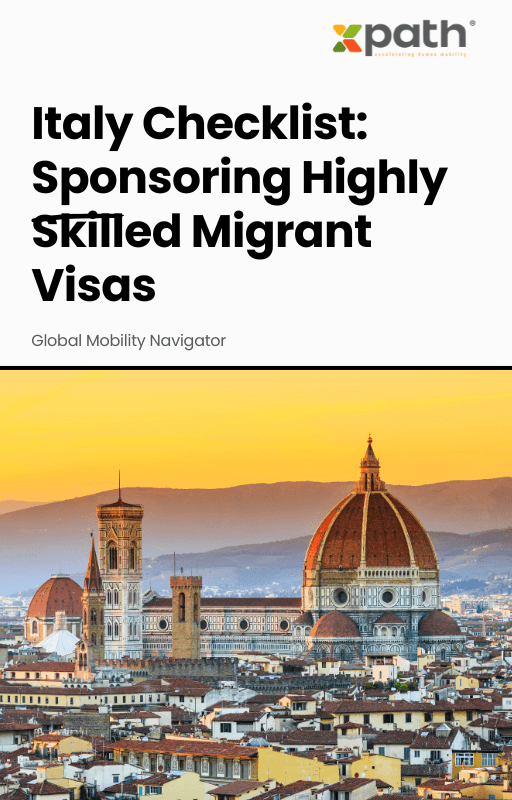Italy Checklist: Sponsoring Highly Skilled Migrant Visas
Grab a copy of a guide to international employee relocation
View E-bookSo, what is global mobility all about? In essence, it’s the broad set of policies, processes, and tools businesses use to manage the relocation and support of their talent internationally. Traditionally, this meant heaps of paperwork, endless spreadsheets, and a maze of compliance hurdles. Now, thanks to digital transformation, global mobility solutions have evolved. Tech platforms like xpath.global are leveraging automation, real-time data, and AI-driven insights to turn this once-cumbersome function into a strategic power play.
Let’s look at the numbers. According to the 2023 Global Mobility Trends Survey, over 65% of companies are now prioritizing tech investments in their mobility programs, a sharp jump from just 48% five years ago. Why the shift? Data analytics and digital mobility tools are unlocking new ways to optimize processes, identify cost savings, and improve both compliance and the employee experience. Automation can cut administrative tasks by more than 50%, and with platforms offering instant access to critical timelines, statuses, and compliance checks, organizations can pivot rapidly—vital in today’s always-connected world.
Let’s break this down with a real-world example. A global tech firm looking to rapidly expand into Southeast Asia faced a logistical and legal labyrinth. By implementing a tech-enabled global mobility solution, the company reduced onboarding times for relocated employees by 40%. Automated document processing and AI-driven compliance checks ensured that assignments launched on time and without the usual red tape. The result? Faster market entry and a happier, more productive workforce.
Similarly, using platforms like xpath.global, businesses gain instant visibility into vendor costings, support services, and cost projections. This helps HR teams anticipate bumps in the road and tailor mobility packages to individual employees—an approach shown to boost retention rates by up to 30% during and after assignments, according to research by the Mercer Global Talent Trends report. That’s not just operational efficiency—it’s a direct line to competitive advantage.
Of course, international mobility is no walk in the park. Companies face a raft of challenges: maintaining compliance with multiple jurisdictions, managing costs, and providing a seamless employee experience. Traditional models often stumble under the weight of manual admin and fragmented supplier networks. This is where tech-enabled platforms shine.
Take compliance, for example. Failure to stay abreast of changing immigration laws can lead to fines and assignment delays. Modern mobility platforms offer real-time legislative updates and built-in risk assessments, slashing the margin of error. Cost, too, gets a digital facelift: analytics dashboards flag over-budget areas and uncover hidden savings by comparing vendor prices across different regions.
Perhaps most importantly, centralized communication hubs empower employees to access support, track their relocation journey, and troubleshoot on the go—drastically improving satisfaction and reducing burnout.
It’s not just about speed or scale. The best mobility solutions are built around people. Tech-enabled platforms like xpath.global let businesses customize relocation journeys, offering tailored support packages, real-time feedback mechanisms, and wellness resources. In a tight global talent market—where 69% of employers report difficulty attracting critical-skill employees—a personalized approach is the difference between winning and losing top performers.
Additionally, digital solutions underpin agile workforce planning. HR leaders can forecast future mobility needs, model “what-if” scenarios, and quickly shift gears in response to geopolitical shifts or health crises—resilience that’s indispensable for today’s multinational enterprises.
The future is clear: As cross-border assignments become both more common and more complex, only those organizations that invest in integrated, tech-powered mobility programs will remain ahead. With automated compliance, data-driven optimization, and a laser-sharp focus on employee experience, solutions like xpath.global empower businesses to turn mobility from a cost center into a strategic lever.
What is a tech-enabled global mobility solution?
These solutions use digital platforms, automation, and real-time analytics to manage all aspects of international employee relocation—from compliance to support, communication, and planning.
Why should companies choose platforms like xpath.global?
xpath.global provides end-to-end visibility, streamlined vendor management, and a customizable experience for both HR teams and employees—delivering faster, more compliant, and more enjoyable relocations.
Can small businesses benefit, or is this just for large enterprises?
Absolutely! Scalable digital platforms are now accessible for organizations of all sizes, making mobility more democratic and opening up global expansion to SMEs.
What’s the biggest challenge with implementing a digital solution?
Change management—shifting mindsets from manual, fragmented ways of working to integrated, digital-first processes. Strong vendor partnerships, like those with xpath.global, ensure a smooth transition.
Ready to transform your mobility program? Explore xpath.global’s solutions.

Italy Checklist: Sponsoring Highly Skilled Migrant Visas
Grab a copy of a guide to international employee relocation
View E-book